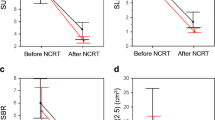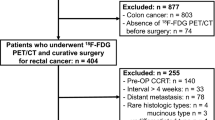Abstract
Purpose
The aim of this study was to prospectively monitor changes in the flow-metabolic phenotype (ΔFMP) of rectal carcinoma (RC) after neoadjuvant chemoradiotherapy (CRT) and to evaluate whether ΔFMP of RC correlate with histopathological prognostic factors including response to CRT.
Methods
Sixteen patients with RC (12 men, mean age 60.7 ± 12.8 years) underwent integrated 18F-fluorodeoxyglucose (FDG) positron emission tomography (PET)/perfusion CT (PET/PCT), followed by neoadjuvant CRT and surgery. In 13 patients, PET/PCT was repeated after CRT. Perfusion [blood flow (BF), blood volume (BV), mean transit time (MTT)] and metabolic [maximum and mean standardized uptake values (SUVmax, SUVmean)] parameters as well as the FMP (BF × SUVmax) were determined before and after CRT by two independent readers and correlated to histopathological prognostic factors of RC (microvessel density, necrosis index, regression index, vascular invasion) derived from resected specimens. The diagnostic performance of ΔFMP for prediction of treatment response was determined.
Results
FMP significantly decreased after CRT (p < 0.001), exploiting higher changes after CRT as compared to changes of perfusion and metabolic parameters alone. Before CRT, no significant correlations were found between integrated PET/PCT and any of the histopathological parameters (all p > 0.05). After CRT, BV and SUVmax correlated positively with the necrosis index (r = 0.67/0.70), SUVmax with the invasion of blood vessels (r = 0.62) and ΔFMP with the regression index (r = 0.88; all p < 0.05). ΔFMP showed high accuracy for prediction of histopathological response to CRT (AUC 0.955, 95 % confidence interval 0.833–1.000, p < 0.01) using a cut-off value of −75 %.
Conclusion
In RC, ΔFMP derived from integrated 18F-FDG PET/PCT is useful for monitoring the effects of neoadjuvant CRT and allows prediction of histopathological response to CRT.




Similar content being viewed by others
References
Gondos A, Hiripi E, Holleczek B, Luttmann S, Eberle A, Brenner H, et al. Survival among adolescents and young adults with cancer in Germany and the United States: an international comparison. Int J Cancer 2013;133:2207–15. doi:10.1002/ijc.28231.
Ferlay J, Shin HR, Bray F, Forman D, Mathers C, Parkin DM. Estimates of worldwide burden of cancer in 2008: GLOBOCAN 2008. Int J Cancer 2010;127:2893–917. doi:10.1002/ijc.25516.
Roh MS, Colangelo LH, O’Connell MJ, Yothers G, Deutsch M, Allegra CJ, et al. Preoperative multimodality therapy improves disease-free survival in patients with carcinoma of the rectum: NSABP R-03. J Clin Oncol 2009;27:5124–30. doi:10.1200/JCO.2009.22.0467.
Sauer R, Becker H, Hohenberger W, Rödel C, Wittekind C, Fietkau R, et al. Preoperative versus postoperative chemoradiotherapy for rectal cancer. N Engl J Med 2004;351:1731–40. doi:10.1056/NEJMoa040694.
Minsky BD, Cohen AM, Kemeny N, Enker WE, Kelsen DP, Reichman B, et al. Enhancement of radiation-induced downstaging of rectal cancer by fluorouracil and high-dose leucovorin chemotherapy. J Clin Oncol 1992;10:79–84.
Bosset JF, Collette L, Calais G, Mineur L, Maingon P, Radosevic-Jelic L, et al. Chemotherapy with preoperative radiotherapy in rectal cancer. N Engl J Med 2006;355:1114–23. doi:10.1056/NEJMoa060829.
Gérard JP, Conroy T, Bonnetain F, Bouché O, Chapet O, Closon-Dejardin MT, et al. Preoperative radiotherapy with or without concurrent fluorouracil and leucovorin in T3-4 rectal cancers: results of FFCD 9203. J Clin Oncol 2006;24:4620–5. doi:10.1200/JCO.2006.06.7629.
Mohiuddin M, Regine WF, Marks GJ, Marks JW. High-dose preoperative radiation and the challenge of sphincter-preservation surgery for cancer of the distal 2 cm of the rectum. Int J Radiat Oncol Biol Phys 1998;40:569–74.
Rau B, Wust P, Hohenberger P, Löffel J, Hünerbein M, Below C, et al. Preoperative hyperthermia combined with radiochemotherapy in locally advanced rectal cancer: a phase II clinical trial. Ann Surg 1998;227:380–9.
Huh JW, Park YA, Jung EJ, Lee KY, Sohn SK. Accuracy of endorectal ultrasonography and computed tomography for restaging rectal cancer after preoperative chemoradiation. J Am Coll Surg 2008;207:7–12. doi:10.1016/j.jamcollsurg.2008.01.002.
Huebner RH, Park KC, Shepherd JE, Schwimmer J, Czernin J, Phelps ME, et al. A meta-analysis of the literature for whole-body FDG PET detection of recurrent colorectal cancer. J Nucl Med 2000;41:1177–89.
Pauwels EK, Coumou AW, Kostkiewicz M, Kairemo K. [18F]Fluoro-2-deoxy-D-glucose positron emission tomography/computed tomography imaging in oncology: initial staging and evaluation of cancer therapy. Med Princ Pract 2013;22:427–37. doi:10.1159/000346303.
Goh V, Halligan S, Daley F, Wellsted DM, Guenther T, Bartram CI. Colorectal tumor vascularity: quantitative assessment with multidetector CT–do tumor perfusion measurements reflect angiogenesis? Radiology 2008;249:510–7. doi:10.1148/radiol.2492071365.
Reiner CS, Roessle M, Thiesler T, Eberli D, Klotz E, Frauenfelder T, et al. Computed tomography perfusion imaging of renal cell carcinoma: systematic comparison with histopathological angiogenic and prognostic markers. Invest Radiol 2013;48:183–91. doi:10.1097/RLI.0b013e31827c63a3.
Wu GY, Ghimire P. Perfusion computed tomography in colorectal cancer: protocols, clinical applications and emerging trends. World J Gastroenterol 2009;15:3228–31.
Kerbel RS. Tumor angiogenesis. N Engl J Med 2008;358:2039–49. doi:10.1056/NEJMra0706596.
Morsbach F, Pfammatter T, Reiner CS, Fischer MA, Sah BR, Winklhofer S, et al. Computed tomographic perfusion imaging for the prediction of response and survival to transarterial radioembolization of liver metastases. Invest Radiol 2013;48:787–94. doi:10.1097/RLI.0b013e31829810f7.
Curvo-Semedo L, Portilha MA, Ruivo C, Borrego M, Leite JS, Caseiro-Alves F. Usefulness of perfusion CT to assess response to neoadjuvant combined chemoradiotherapy in patients with locally advanced rectal cancer. Acad Radiol 2012;19:203–13. doi:10.1016/j.acra.2011.10.019.
Bellomi M, Petralia G, Sonzogni A, Zampino MG, Rocca A. CT perfusion for the monitoring of neoadjuvant chemotherapy and radiation therapy in rectal carcinoma: initial experience. Radiology 2007;244:486–93. doi:10.1148/radiol.2442061189.
Sahani DV, Kalva SP, Hamberg LM, Hahn PF, Willett CG, Saini S, et al. Assessing tumor perfusion and treatment response in rectal cancer with multisection CT: initial observations. Radiology 2005;234:785–92. doi:10.1148/radiol.2343040286.
Janssen MH, Aerts HJ, Buijsen J, Lambin P, Lammering G, Öllers MC. Repeated positron emission tomography-computed tomography and perfusion-computed tomography imaging in rectal cancer: fluorodeoxyglucose uptake corresponds with tumor perfusion. Int J Radiat Oncol Biol Phys 2012;82:849–55. doi:10.1016/j.ijrobp.2010.10.029.
Veit-Haibach P, Schmid D, Strobel K, Soyka JD, Schaefer NG, Haerle SK, et al. Combined PET/CT-perfusion in patients with head and neck cancers. Eur Radiol 2013;23:163–73. doi:10.1007/s00330-012-2564-5.
Goh V, Rodriguez-Justo M, Engledow A, Shastry M, Endozo R, Peck J, et al. Assessment of the metabolic flow phenotype of primary colorectal cancer: correlations with microvessel density are influenced by the histological scoring method. Eur Radiol 2012;22:1687–92. doi:10.1007/s00330-012-2423-4.
Goh V, Engledow A, Rodriguez-Justo M, Shastry M, Peck J, Blackman G, et al. The flow-metabolic phenotype of primary colorectal cancer: assessment by integrated 18F-FDG PET/perfusion CT with histopathologic correlation. J Nucl Med 2012;53:687–92. doi:10.2967/jnumed.111.098525.
Weichert W, Schewe C, Lehmann A, Sers C, Denkert C, Budczies J, et al. KRAS genotyping of paraffin-embedded colorectal cancer tissue in routine diagnostics: comparison of methods and impact of histology. J Mol Diagn 2010;12:35–42. doi:10.2353/jmoldx.2010.090079.
Sobin LHGM, Wittekind C, Compton CC. TNM classification of malignant tumours. 7th ed. Chichester: Wiley-Blackwell; 2010.
Pollheimer MJ, Kornprat P, Lindtner RA, Harbaum L, Schlemmer A, Rehak P, et al. Tumor necrosis is a new promising prognostic factor in colorectal cancer. Hum Pathol 2010;41:1749–57. doi:10.1016/j.humpath.2010.04.018.
Dworak O, Keilholz L, Hoffmann A. Pathological features of rectal cancer after preoperative radiochemotherapy. Int J Colorectal Dis 1997;12:19–23.
Veit-Haibach P, Treyer V, Strobel K, Soyka JD, Husmann L, Schaefer NG, et al. Feasibility of integrated CT-liver perfusion in routine FDG-PET/CT. Abdom Imaging 2010;35:528–36. doi:10.1007/s00261-009-9559-y.
Lin L, Torbeck LD. Coefficient of accuracy and concordance correlation coefficient: new statistics for methods comparison. PDA J Pharm Sci Technol 1998;52:55–9.
Guillem JG, Chessin DB, Cohen AM, Shia J, Mazumdar M, Enker W, et al. Long-term oncologic outcome following preoperative combined modality therapy and total mesorectal excision of locally advanced rectal cancer. Ann Surg 2005;241:829–36. discussion 36-8.
Roberts GW, Larson KB, Spaeth EE. The interpretation of mean transit time measurements for multiphase tissue systems. J Theor Biol 1973;39:447–75.
Groves AM, Wishart GC, Shastry M, Moyle P, Iddles S, Britton P, et al. Metabolic-flow relationships in primary breast cancer: feasibility of combined PET/dynamic contrast-enhanced CT. Eur J Nucl Med Mol Imaging 2009;36:416–21. doi:10.1007/s00259-008-0948-1.
Miles KA, Griffiths MR, Keith CJ. Blood flow-metabolic relationships are dependent on tumour size in non-small cell lung cancer: a study using quantitative contrast-enhanced computer tomography and positron emission tomography. Eur J Nucl Med Mol Imaging 2006;33:22–8. doi:10.1007/s00259-005-1932-7.
Padhani AR, Miles KA. Multiparametric imaging of tumor response to therapy. Radiology 2010;256:348–64. doi:10.1148/radiol.10091760.
Dunnwald LK, Gralow JR, Ellis GK, Livingston RB, Linden HM, Specht JM, et al. Tumor metabolism and blood flow changes by positron emission tomography: relation to survival in patients treated with neoadjuvant chemotherapy for locally advanced breast cancer. J Clin Oncol 2008;26:4449–57. doi:10.1200/JCO.2007.15.4385.
Tseng J, Dunnwald LK, Schubert EK, Link JM, Minoshima S, Muzi M, et al. 18F-FDG kinetics in locally advanced breast cancer: correlation with tumor blood flow and changes in response to neoadjuvant chemotherapy. J Nucl Med 2004;45:1829–37.
Komar G, Kauhanen S, Liukko K, Seppänen M, Kajander S, Ovaska J, et al. Decreased blood flow with increased metabolic activity: a novel sign of pancreatic tumor aggressiveness. Clin Cancer Res 2009;15:5511–7. doi:10.1158/1078-0432.CCR-09-0414.
Specht JM, Kurland BF, Montgomery SK, Dunnwald LK, Doot RK, Gralow JR, et al. Tumor metabolism and blood flow as assessed by positron emission tomography varies by tumor subtype in locally advanced breast cancer. Clin Cancer Res 2010;16:2803–10. doi:10.1158/1078-0432.CCR-10-0026.
Bisdas S, Spicer K, Rumboldt Z. Whole-tumor perfusion CT parameters and glucose metabolism measurements in head and neck squamous cell carcinomas: a pilot study using combined positron-emission tomography/CT imaging. AJNR Am J Neuroradiol 2008;29:1376–81. doi:10.3174/ajnr.A1111.
Hirasawa S, Tsushima Y, Takei H, Hirasawa H, Taketomi-Takahashi A, Takano A, et al. Inverse correlation between tumor perfusion and glucose uptake in human head and neck tumors. Acad Radiol 2007;14:312–8. doi:10.1016/j.acra.2006.12.017.
Martoni AA, Di Fabio F, Pinto C, Castellucci P, Pini S, Ceccarelli C, et al. Prospective study on the FDG-PET/CT predictive and prognostic values in patients treated with neoadjuvant chemoradiation therapy and radical surgery for locally advanced rectal cancer. Ann Oncol 2011;22:650–6. doi:10.1093/annonc/mdq433.
Greenson JK, Bonner JD, Ben-Yzhak O, Cohen HI, Miselevich I, Resnick MB, et al. Phenotype of microsatellite unstable colorectal carcinomas: well-differentiated and focally mucinous tumors and the absence of dirty necrosis correlate with microsatellite instability. Am J Surg Pathol 2003;27:563–70.
Warburg O. On the origin of cancer cells. Science 1956;123:309–14.
Li ZP, Meng QF, Sun CH, Xu DS, Fan M, Yang XF, et al. Tumor angiogenesis and dynamic CT in colorectal carcinoma: radiologic-pathologic correlation. World J Gastroenterol 2005;11:1287–91.
Feng ST, Sun CH, Li ZP, Mak HK, Peng ZP, Guo HY, et al. Evaluation of angiogenesis in colorectal carcinoma with multidetector-row CT multislice perfusion imaging. Eur J Radiol 2010;75:191–6. doi:10.1016/j.ejrad.2009.04.058.
Li C, Gardy R, Seon BK, Duff SE, Abdalla S, Renehan A, et al. Both high intratumoral microvessel density determined using CD105 antibody and elevated plasma levels of CD105 in colorectal cancer patients correlate with poor prognosis. Br J Cancer 2003;88:1424–31. doi:10.1038/sj.bjc.6600874.
Weidner N. Intratumor microvessel density as a prognostic factor in cancer. Am J Pathol 1995;147:9–19.
Hansen S, Grabau DA, Rose C, Bak M, Sørensen FB. Angiogenesis in breast cancer: a comparative study of the observer variability of methods for determining microvessel density. Lab Invest 1998;78:1563–73.
Dhadda AS, Dickinson P, Zaitoun AM, Gandhi N, Bessell EM. Prognostic importance of Mandard tumour regression grade following pre-operative chemo/radiotherapy for locally advanced rectal cancer. Eur J Cancer 2011;47:1138–45. doi:10.1016/j.ejca.2010.12.006.
Losi L, Luppi G, Gavioli M, Iachetta F, Bertolini F, D’Amico R, et al. Prognostic value of Dworak grade of regression (GR) in patients with rectal carcinoma treated with preoperative radiochemotherapy. Int J Colorectal Dis 2006;21:645–51. doi:10.1007/s00384-005-0061-x.
Goh V, Liaw J, Bartram CI, Halligan S. Effect of temporal interval between scan acquisitions on quantitative vascular parameters in colorectal cancer: implications for helical volumetric perfusion CT techniques. AJR Am J Roentgenol 2008;191:W288–92. doi:10.2214/AJR.07.3985.
Goh V, Halligan S, Bartram CI. Quantitative tumor perfusion assessment with multidetector CT: are measurements from two commercial software packages interchangeable? Radiology 2007;242:777–82. doi:10.1148/radiol.2423060279.
Goh V, Halligan S, Gharpuray A, Wellsted D, Sundin J, Bartram CI. Quantitative assessment of colorectal cancer tumor vascular parameters by using perfusion CT: influence of tumor region of interest. Radiology 2008;247:726–32. doi:10.1148/radiol.2473070414.
Conflicts of interest
None.
Author information
Authors and Affiliations
Corresponding author
Rights and permissions
About this article
Cite this article
Fischer, M.A., Vrugt, B., Alkadhi, H. et al. Integrated 18F-FDG PET/perfusion CT for the monitoring of neoadjuvant chemoradiotherapy in rectal carcinoma: correlation with histopathology. Eur J Nucl Med Mol Imaging 41, 1563–1573 (2014). https://doi.org/10.1007/s00259-014-2752-4
Received:
Accepted:
Published:
Issue Date:
DOI: https://doi.org/10.1007/s00259-014-2752-4




